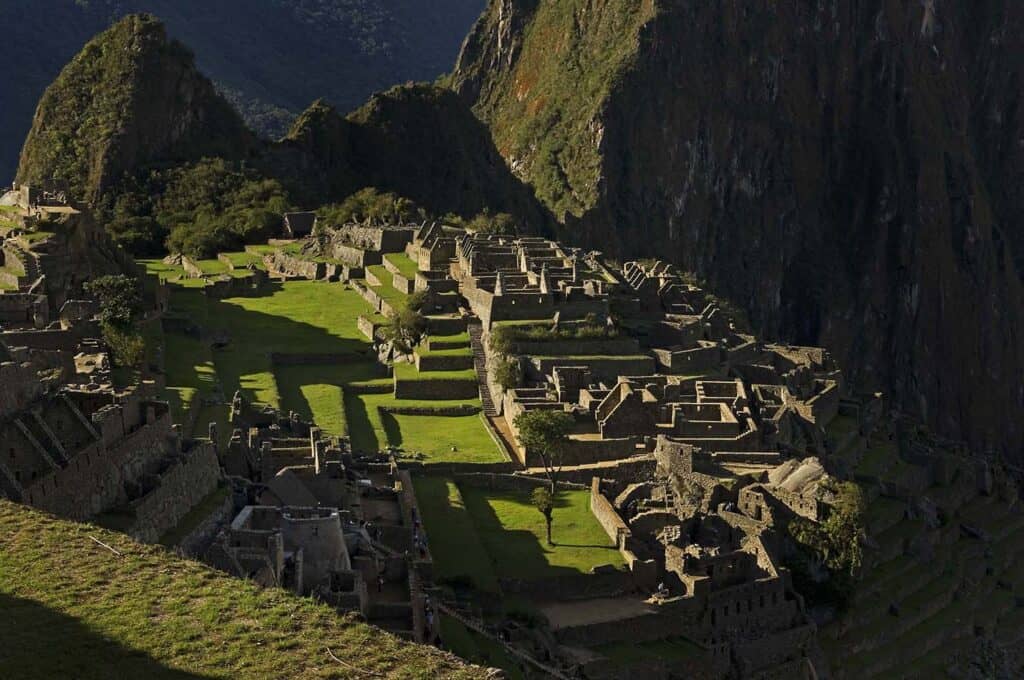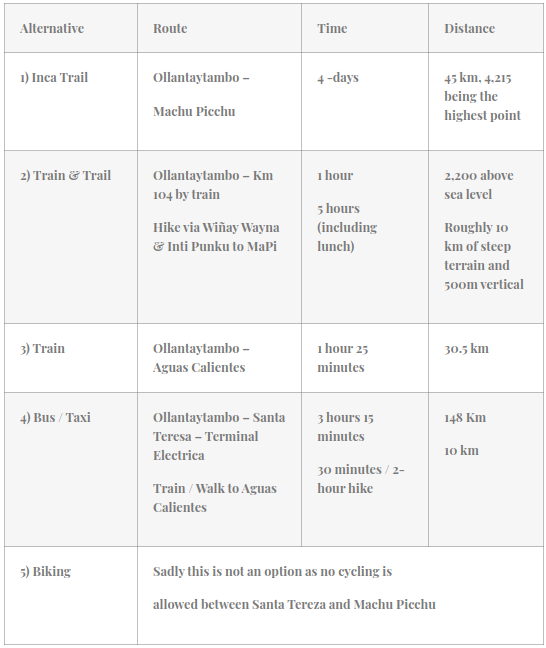Machu Picchu, the lost city of the Incas and one of the Seven Wonders of the World, can be easily reached from el Valle Sagrado (Cusco’s Sacred Valley).
Machu Picchu is located roughly 80 kilometers northwest of Cusco, at the opposite end of the Sacred Valley, above the town of Aguas Calientes (aka Machu Picchu Pueblo).
Its coordinates are 13°09′48″S 72°32′44″W
The Sanctuary is at an altitude of 2,430 meters above sea level (1,000 meters lower than Cusco) so we advise travelers coming from sea level to visit Machu Picchu at the beginning of their journey and to visit Cusco at the end, once their bodies have acclimatized to the altitude.

Paradoxically, the Southern Hemisphere’s winter months have the best weather to visit the Andes Mountains, as they coincide with the dry season. The dry season is from April to mid-November and the wet season from mid-November to March. Visibility will be a big factor in your overall experience when visiting the Sanctuary, so it is safer to travel during the drier months.
Having said that, you can still score beautiful weather during the rainy season with a fraction of the crowds. The wet season is also a lot greener, so there are pros and cons to each season and you can generally travel all-year round.
Dry Season (winter)
April – November
More crowded, Drier, Better Visibility
Wet season (summer)
November – March
Less Crowded, greener, Less visibility
In order to enter Machu Picchu, the visitor must first acquire entry tickets (Boleto Machu Picchu). This can be done via the official website Reservas Machu Picchu.
You can book a Machu Picchu Ticket that gives you a one-hour time slot within which to enter the Sanctuary. The first window is from 6:00 to 7:00 and the last window from 14:00 to 15:00. The Sanctuary closes at 17:30.

It is compulsory for visitors to hire a guide to Machu Picchu. There are officially guided tours in English and Spanish, or individual guides can be booked in English, Spanish, French and Portuguese.
A guide can be booked on Boleto Machu Picchu.
A word of caution: Reviews of the guiding standards can be mixed. At Las Qolqas Eco Resort we work with a panel of highly experienced guides, who are fluent in multiple languages.
Las Qolqas Activities Machu Picchu
There are several ways of reaching Machu Picchu, so read on to get our take on what route/means of transportation would suit you best.
Machu Picchu can be reached on foot, by train, or by road. Below we elaborate on the various alternatives:

Probably the most emblematic way to get to Machu Picchu is by Hiking the Inca Trail.
A four-day, three-night journey that starts a twenty-minute drive from Ollantaytambo at a suspension bridge over the Vilcanota River, next to km 82.
The trail itself is only 45km long, but there are big altitude differentials, particularly on day 2 when the highest pass exceeds 4,200 meters. Your lungs will suffer on the way up and your knees will suffer on the way down. Proper hiking shoes are a must and a good pair of walking sticks will come in handy. BUT make sure you equip them with rubber tips as otherwise you will not be able to take them on the trail. It is a memorable journey and one that we highly recommend.

Proper hiking shoes are a must and a good pair of walking sticks will come in handy. BUT make sure you equip them with rubber tips as otherwise you will not be able to take them on the trail. It is a memorable journey and one that we highly recommend.
The Trail has a limit of 500 visitors per day and each visitor requires a Trail permit and an officially certified guide for a group of up to eight people.
Two very professional operators are:
There is a shorter option for those who have limited time, but want to experience the Inca Trail. This alternative can be done in one single day as follows:
Depart by train to Machu Picchu at 6:00 from Ollantaytambo to Km 104. Hike to the Citadel of Wiñay Wayna for three hours and stop for a picnic lunch. Walk for another hour and enter Machu Picchu via Inti Punku (Gate of the Sun) at around 13:00. Spend two to three hours exploring the Sitadel just as the morning visitors are exiting, but before the afternoon shift arrives. Take the 18:00 train and be back in Ollantaytambo on time for a foot massage, a refreshment and a delicious meal. This is a rewarding compromise, which will give you a taste of the intensity of the Inca Trail and a visit to Machu Picchu without the need to take any luggage.
By far the most common (and practical) way to visit Machu Picchu is by train from Ollantaytambo to Aguas Calientes (Machu Picchu Pueblo). This trip can be conveniently done in a single day so you can use Ollantaytambo as a hub without the need of taking your luggage with you, plus accommodations in Ollantaytambo tend to be better value.
The earliest trains to Machu Picchu village leave Ollantaytambo at around 5:00 and arrive in Aguas Calientes at 6:30. The last returning before 22:00 and arriving in Ollantaytambo at 23:30.
Schedules do change depending on the season, so we recommend for you to check the websites of the two train operators in order to plan your journey.
Peru Rail
Inca Rail
They both operate multiple services for a range of budgets, so take your time to look at the various options and decide which schedule/price combination suits you best. The reception at Las Qolqas Eco Resort can help you book your tickets, but bear in mind, during high season popular trains sell-out fast.
We would typically recommend leaving Ollantaytambo between 7:00 and 07:30, arriving in Aguas Calientes before 09:00. Taking the bus up to Machu Picchu by 10:00 (more on this to follow) and entering the citadel before 11:00.
After spending about three hours exploring the site, going down to Aguas Calientes by 14:00 and having lunch at El Indio Feliz or at Café Inkaterra
Both are excellent options, albeit at slightly different ends of the price scale.
We recommend for you to time your return train between 16:00 and 16:30 in order to reach Ollantaytambo by happy hour. Alternatively, you can take a more leisurely lunch and take an 18:00 return train for arrival by 20:00, but this will make your day rather long.
If you choose to visit Machu Picchu in the afternoon, then we advice you to leave Ollantaytambo at around 11:00 with a lunchbox to eat on the train. Arrive in Aguas Calientes by 12:30 and be up in Machu Picchu by 14:00. You will benefit from a sun which is lower on the horizon (hence cooler), warmer hues for your pictures (reddish glow), shadows providing better contrast for your pictures, better visibility and smaller crowds.
You would exit the sanctuary by 17:30 and have dinner at either of the two options mentioned earlier. If you choose this option make sure to purchase your return train ticket well in advance as the last trains tend to sell-out quickly.

Once you arrive by train to Aguas Calientes, you still need to get up to Machu Picchu. This is an altitude differential of roughly 400 meters. We recommend taking the bus, as the path up is rather steep and it crisscrosses the road taken by the buses, making it somewhat dangerous. Tickets can be purchased online at
Ticket Machu Picchu , or at the ticket office in the center of town.

If you are on a budget, do not suffer from motion sickness and do not mind roughing it, then there is an option to travel by car from Ollantaytambo to the Power Station (hidroelectrica) near Machu Picchu.
The 148km trip is very scenic, but dangerous and not an option that should be considered by those who suffer from motion sickness, as this white-knuckle drive takes roughly three hours and fifteen minutes.
Once at the power station, travelers can reach Aguas Calientes by taking a 30-minute train (only one shift in the afternoon), or by doing a two-hour hike along the train tracks. If you choose this option you should plan on spending the night in Aguas Calientes and visiting the Sanctuary the following morning.
Cars can be booked in the main square of Ollantaytambo, where you can join a mini bus or book a private taxi.
Summary of ways to get there


The cost of your trip to Machu Picchu will depend on many factors:
There are many moving parts and regulations. At Las Qolqas Eco Resort we will gladly arrange the most suitable combination for our guests based on availability. We advise our guests to book their trip as soon as they confirm their travel dates because of the finite number of slots available at the various stages of the journey.
A broad indication of the price ranges you can expect for the various components of your journey are below:
Entrance ticket to Machu Picchu
Prices vary. As of July 2021 Adults pay S/152 (+/- $ 40), Students pay S 77 ($ 20.25) and Minors pay S 70 ($ 18,40)
Citizens from Peru, Ecuador Bolivia and Colombia pay S/64 per adult and S/32 per student or child.
Guide for Machu Picchu:
Visitors must use the services of a guide when visiting Machu Picchu, at Boleto Machu Picchu
$ 60 for a group of up to 8 people
Accredited guides can also be arranged in advance from a variety of travel agents.
Transportation:
By Train to Machu Picchu there are two operators:
Their basic train is the Expedition with a one-way ticket averaging $ 65
Their High-end train is the Vistadome, which averages $ 85 for one way.
Their Luxury train is the Hiram Bingham, which only goes from Cusco (Poroy Station) to Aguas Calientes. A one-way ticket will set you back approximately $ 500. All three trains will offer promotions from time to time.
The bus from Aguas Calientes to Machu Picchu can be booked on Boleto Machu Picchu
Ticket $ 14 one-way for Peruvians, or $18 one-way for Foreigners.
The budget option: A bus ticket from Ollantaytambo to the Hydroelectric Power plant is roughly $ 18 (one-way) and $ 30 (round trip)
Whichever route you choose, you are bound to have a wonderful experience as this is a site, which should rightly be on most traveler’s bucket lists.
Enjoy your journey!